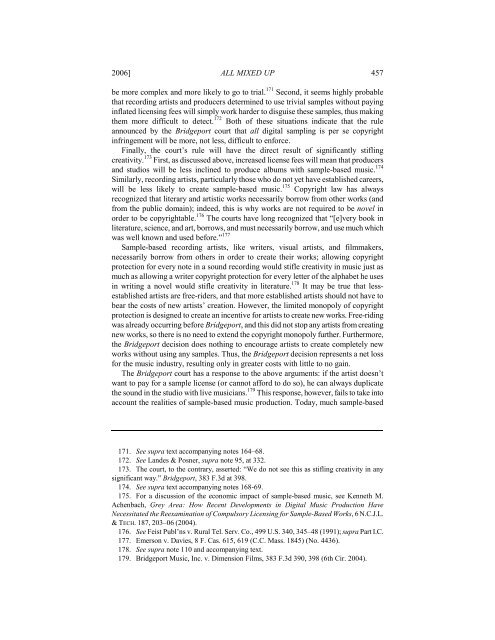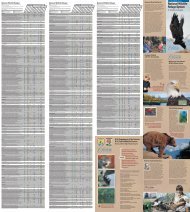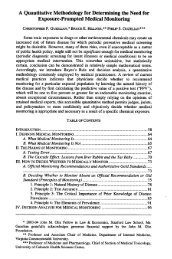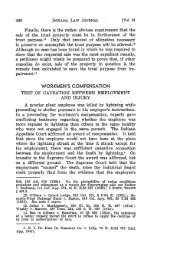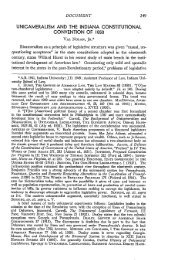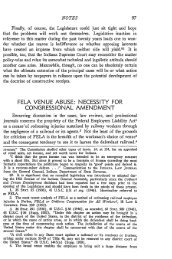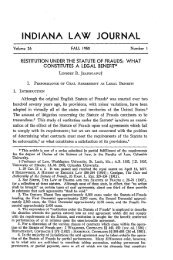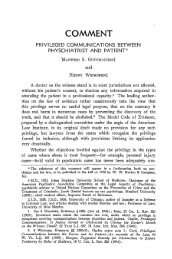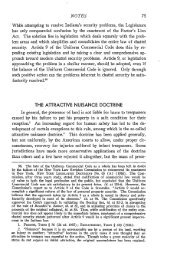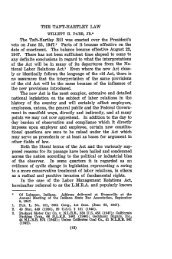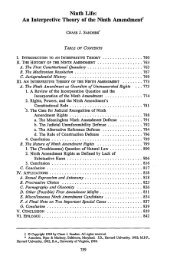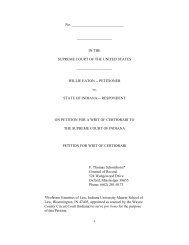Bridgeport Music v. Dimension Films - Indiana University School of ...
Bridgeport Music v. Dimension Films - Indiana University School of ...
Bridgeport Music v. Dimension Films - Indiana University School of ...
Create successful ePaper yourself
Turn your PDF publications into a flip-book with our unique Google optimized e-Paper software.
2006] ALL MIXED UP 457<br />
be more complex and more likely to go to trial. 171 Second, it seems highly probable<br />
that recording artists and producers determined to use trivial samples without paying<br />
inflated licensing fees will simply work harder to disguise these samples, thus making<br />
them more difficult to detect. 172 Both <strong>of</strong> these situations indicate that the rule<br />
announced by the <strong>Bridgeport</strong> court that all digital sampling is per se copyright<br />
infringement will be more, not less, difficult to enforce.<br />
Finally, the court’s rule will have the direct result <strong>of</strong> significantly stifling<br />
creativity. 173 First, as discussed above, increased license fees will mean that producers<br />
and studios will be less inclined to produce albums with sample-based music. 174<br />
Similarly, recording artists, particularly those who do not yet have established careers,<br />
will be less likely to create sample-based music. 175 Copyright law has always<br />
recognized that literary and artistic works necessarily borrow from other works (and<br />
from the public domain); indeed, this is why works are not required to be novel in<br />
order to be copyrightable. 176 The courts have long recognized that “[e]very book in<br />
literature, science, and art, borrows, and must necessarily borrow, and use much which<br />
was well known and used before.” 177<br />
Sample-based recording artists, like writers, visual artists, and filmmakers,<br />
necessarily borrow from others in order to create their works; allowing copyright<br />
protection for every note in a sound recording would stifle creativity in music just as<br />
much as allowing a writer copyright protection for every letter <strong>of</strong> the alphabet he uses<br />
in writing a novel would stifle creativity in literature. 178 It may be true that lessestablished<br />
artists are free-riders, and that more established artists should not have to<br />
bear the costs <strong>of</strong> new artists’ creation. However, the limited monopoly <strong>of</strong> copyright<br />
protection is designed to create an incentive for artists to create new works. Free-riding<br />
was already occurring before <strong>Bridgeport</strong>, and this did not stop any artists from creating<br />
new works, so there is no need to extend the copyright monopoly further. Furthermore,<br />
the <strong>Bridgeport</strong> decision does nothing to encourage artists to create completely new<br />
works without using any samples. Thus, the <strong>Bridgeport</strong> decision represents a net loss<br />
for the music industry, resulting only in greater costs with little to no gain.<br />
The <strong>Bridgeport</strong> court has a response to the above arguments: if the artist doesn’t<br />
want to pay for a sample license (or cannot afford to do so), he can always duplicate<br />
the sound in the studio with live musicians. 179 This response, however, fails to take into<br />
account the realities <strong>of</strong> sample-based music production. Today, much sample-based<br />
171. See supra text accompanying notes 164–68.<br />
172. See Landes & Posner, supra note 95, at 332.<br />
173. The court, to the contrary, asserted: “We do not see this as stifling creativity in any<br />
significant way.” <strong>Bridgeport</strong>, 383 F.3d at 398.<br />
174. See supra text accompanying notes 168-69.<br />
175. For a discussion <strong>of</strong> the economic impact <strong>of</strong> sample-based music, see Kenneth M.<br />
Achenbach, Grey Area: How Recent Developments in Digital <strong>Music</strong> Production Have<br />
Necessitated the Reexamination <strong>of</strong> Compulsory Licensing for Sample-Based Works, 6 N.C.J.L.<br />
& TECH. 187, 203–06 (2004).<br />
176. See Feist Publ’ns v. Rural Tel. Serv. Co., 499 U.S. 340, 345–48 (1991); supra Part I.C.<br />
177. Emerson v. Davies, 8 F. Cas. 615, 619 (C.C. Mass. 1845) (No. 4436).<br />
178. See supra note 110 and accompanying text.<br />
179. <strong>Bridgeport</strong> <strong>Music</strong>, Inc. v. <strong>Dimension</strong> <strong>Films</strong>, 383 F.3d 390, 398 (6th Cir. 2004).


